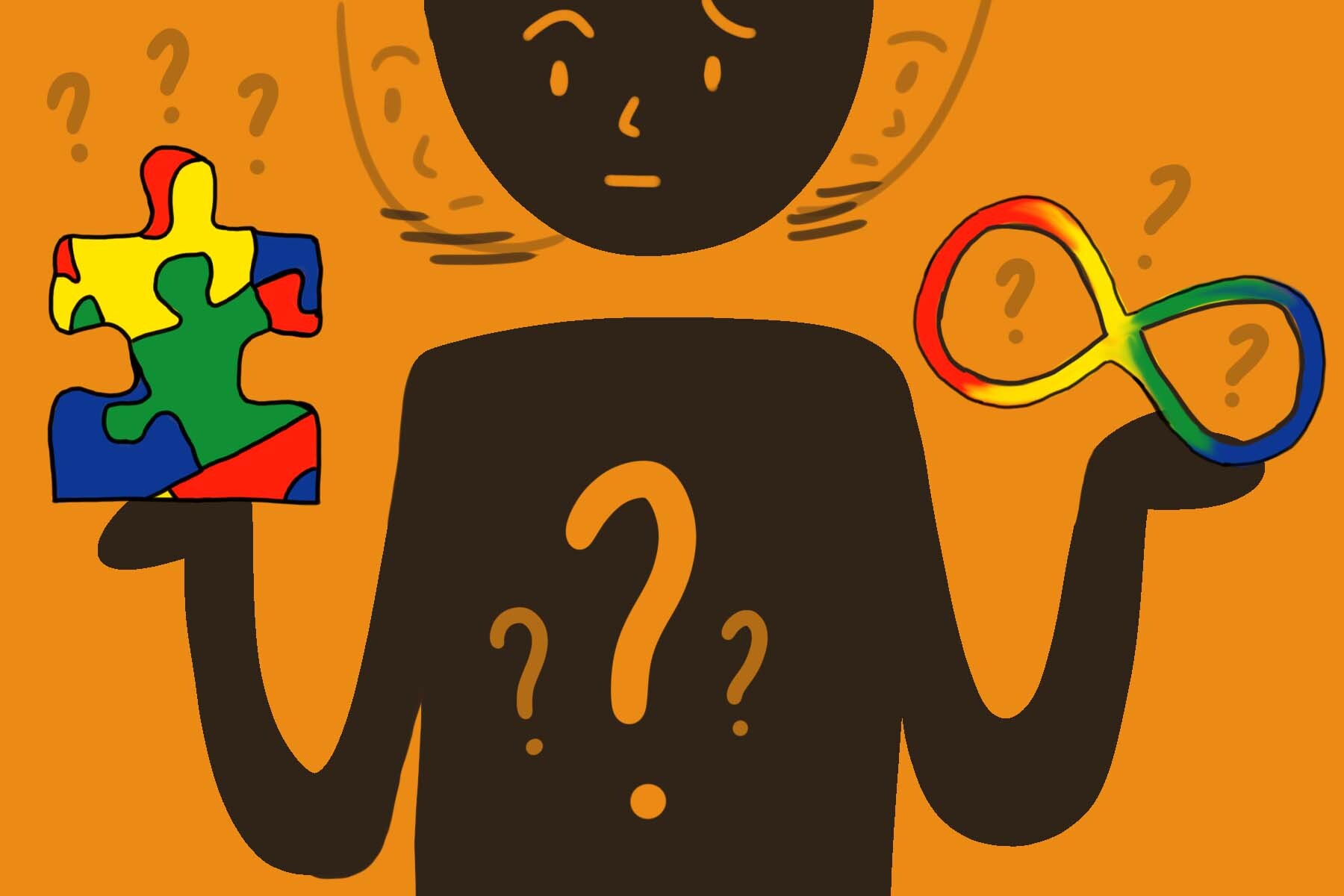This article has been hard for me to write so I’ve tried to get the ball rolling from a few different angles. There’s the “nothing but the facts” angle where I could introduce the origins of the puzzle piece and the infinity symbol, letting the facts speak for themselves. There’s the “experience” angle where I share my personal opinions of these symbols as an autistic adult. There’s also a completely different angle, where I could dive into the significance of symbolism and how it plays a huge factor in our society; symbolism’s role in our society is why I’m writing this article in the first place.
With each draft, I’m left unsatisfied with the result. This issue has the same underlying cause as most other problems the autistic community faces: We are silenced constantly. And I’m not talking about allistic caretakers, doctors or teachers who work with autistic people. I’m talking about the voices of those who are actually autistic — voices that are regularly silenced in conversations where they should be centered.
One area where this is often the case is the puzzle piece versus infinity symbol debate. For these next few minutes of your life, I’m going to lay out the information that is pertinent to this conversation. Where did these symbols come from? Why does it matter? Which one should we use? I’ll give you a spoiler alert right now: I hate the puzzle piece symbol and I think we should stop using it. Still, I’d like you to take this as an opportunity to gain a deeper understanding of both symbols so you can draw your own conclusions and support your autistic loved ones.
Where Did The Puzzle Piece Come From?
In April of 1963, the first symbol for autism was published by the National Autistic Society in London. It was created by board member Gerald Gasson and the design was a puzzle piece and a crying child. Helen Allison of the National Autistic Society described the meaning of this symbol as follows: “The puzzle piece is so effective because it tells us something about autism: our children are handicapped by a puzzling condition; this isolates them from normal human contact and therefore they do not ‘fit in’. The suggestion of a weeping child is a reminder that autistic people do indeed suffer from their handicap.”
Suffering, not fitting in, nobody understanding. What a positive image, right? Of course, this was a really long time ago and the symbol and its meaning have evolved since then, but we shouldn’t ignore why it was created in the first place. Its origin influences our perception of autism to this day.
We see the classic autism puzzle piece ribbon design, which was created in 1999 by the Autism Society, much more often today. Quoted directly from their website, “The puzzle pattern reflects the complexity of the autism spectrum. The different colors and shapes represent the diversity of the people and families living with the condition. The brightness of the ribbon signals hope — hope that through increased awareness of autism, and through early intervention and access to appropriate services/supports, people with autism will lead full lives able to interact with the world on their own terms.” This description seems ideal in a lot of ways, but the comment section of their website alone has a lot of contradicting views on what the puzzle piece actually reflects.
The Autism Society has a section on their website where they ask readers what the puzzle piece means to them and there are lots of contrasting feelings tied to the symbol. Some people find it comforting, explaining how it means “that I am not alone” or how it serves as a reminder “that I am part of the great puzzle of life.” Others don’t see it in such a positive light: “It means nothing to me, but more importantly it means nothing to my son. Autism may have seemed a bit ‘puzzling’ at the beginning but now the only puzzle pieces we are concerned about are the ones that disappear under the stove.”
This view is one I resonate with a lot: “I don’t like the symbol of the puzzle or blue lights. They remind me of loneliness, sadness (blue), and isolation (missing piece). I know that’s not what it’s supposed to mean. They just don’t make me or my son feel hopeful, understood, special, belonging. Autism is just really hard.” Autism is hard because of how misunderstood it is to most of the world. Using a symbol that pushes the “confusion” point further makes that the center of how we view autism.
Although the puzzle piece symbol may have good intentions, those good intentions don’t matter nearly as much as the negative impact it often has on autistic people. It tells me that I’m missing something or that I’m too “puzzling” to fit in — but those qualities don’t define me. It also rubs me the wrong way that a lot of the autism puzzle piece campaigns are pushed by Autism Speaks, an organization that supports a cure for autism and fear mongers. Other reasons I’ve seen for throwing the puzzle piece in the trash is because it’s an infantilizing and childish-looking symbol, it implies a need to solve the “autistic puzzle” (meaning finding a cure) and many other critiques that you can hear by listening to other autistic individuals.
Is the Infinity Symbol Better?
Yes, and I’ll explain why. As our understanding of autism has evolved, we’ve learned that it’s a spectrum of completely different needs and experiences for each autistic individual. People in the autistic community don’t see themselves as having any “missing pieces” or being “too puzzling” to fit into society. After all, I don’t think it’s much of a stretch to say that a puzzle piece symbol reflects how we’re a problem to solve instead of people who just want to be accepted and understood.
To reflect this spectrum and the diversity of each autistic person, the infinity sign became the new symbol for autism in February of 2018. According to goodautismschool.com, “This symbol has come to represent the need for us to be more sensitive to changes that lead to better lives and results for individuals with autism and their families. This change in the representation of the symbol also guarantees cooperation and sharing between the rest of the society and individuals with autism.”
There seems to be a perception that there’s a strong divide on what we should be using as a symbol, but is there a big division within the autistic community? In my experience, the majority of individuals who are actually autistic dislike the puzzle piece and favor the infinity symbol. The puzzle pieces are more often used by allistic people. This article has a very interesting thread on the topic.
Commenter Maxfield Sparrow has a take I strongly agree with: “There’s only ‘no consensus’ when you look at what everyone is saying. If you only ask Autistic people, over 80% want to get rid of the puzzle piece. We choose to represent ourselves with an infinity symbol: rainbow-colored for Neurodiversity or golden for autism.”
Still, it’s important to note that no autistic individual can speak for everyone. Lo’ri Trigg responded to Sparrow with a contrasting take: “I’m autistic and I LOVE the puzzle piece (just not blue). It makes more sense than infinity. I only take issue with the blue puzzle piece because it is a symbol for autism speaks, which is a horrid organization that seeks to cure autism and views it as a burden and noose around the neck of caregivers.”
What Do I Think?
In the beginning, I mentioned how the underlying issue is that allistic people are talking over autistic people. The puzzle piece is a symbol that was created by allistic people who wanted to emphasize the “misery and mystery” of autism. I’m not miserable and I’m not mysterious. Autistic people understand autism; we live and breathe autism 24/7. If we’re miserable, it’s because we live in a world that tries to tell us that we should be fixed, while talking over us in discussions about us.
The infinity sign is a much better symbol for reflecting today’s understanding of autism, yet I see the puzzle piece much more frequently. When you’re spreading awareness for autism, don’t slap a puzzle piece onto your social media page and call that a job well done. Think about what that symbol actually means, especially for the community it’s directly affecting.

















